
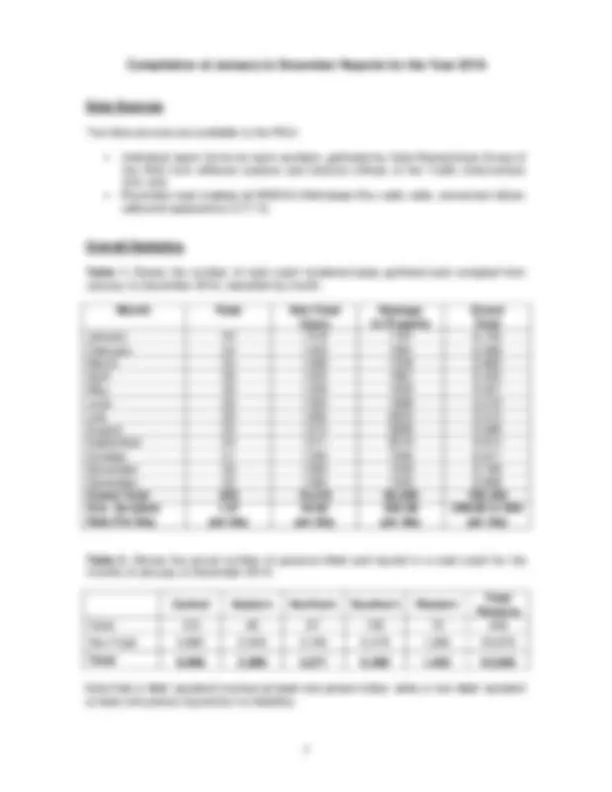
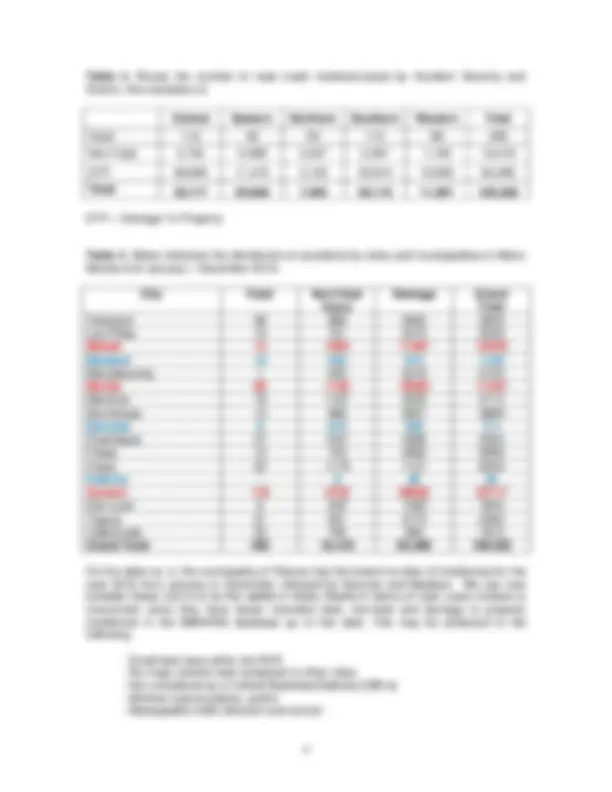
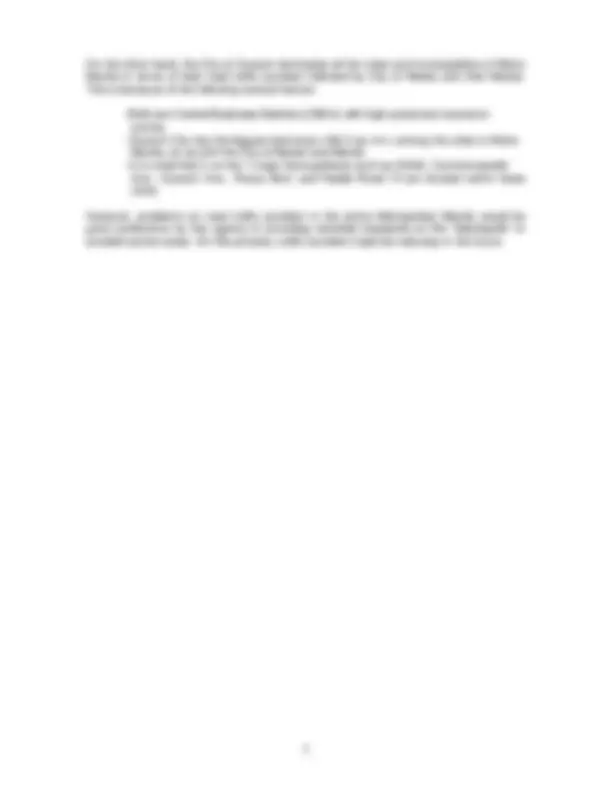
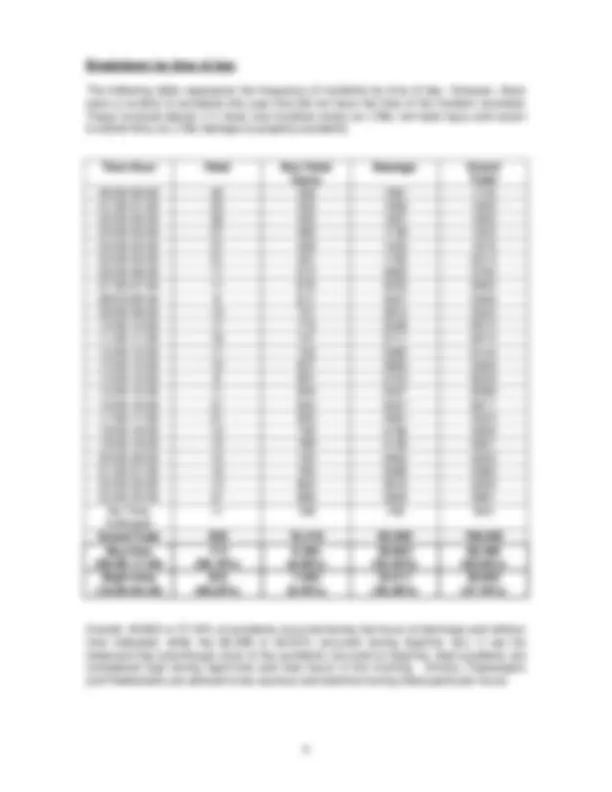
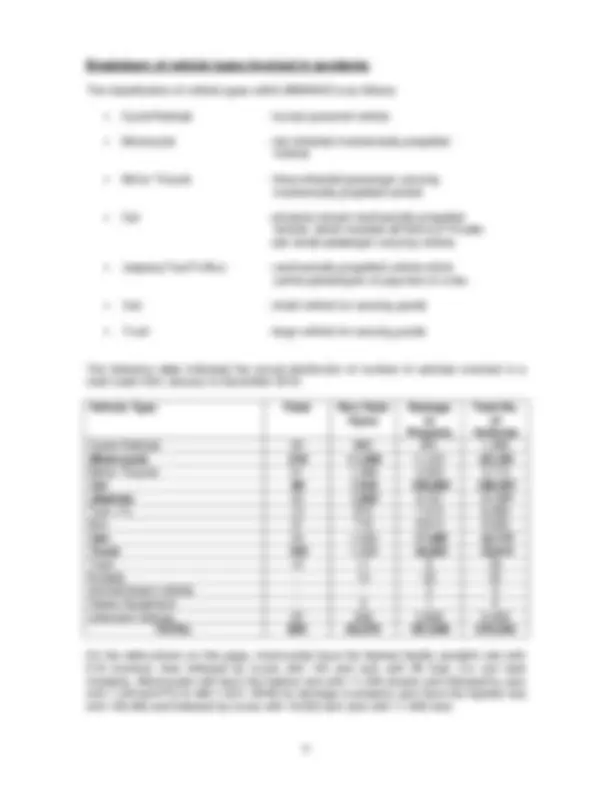
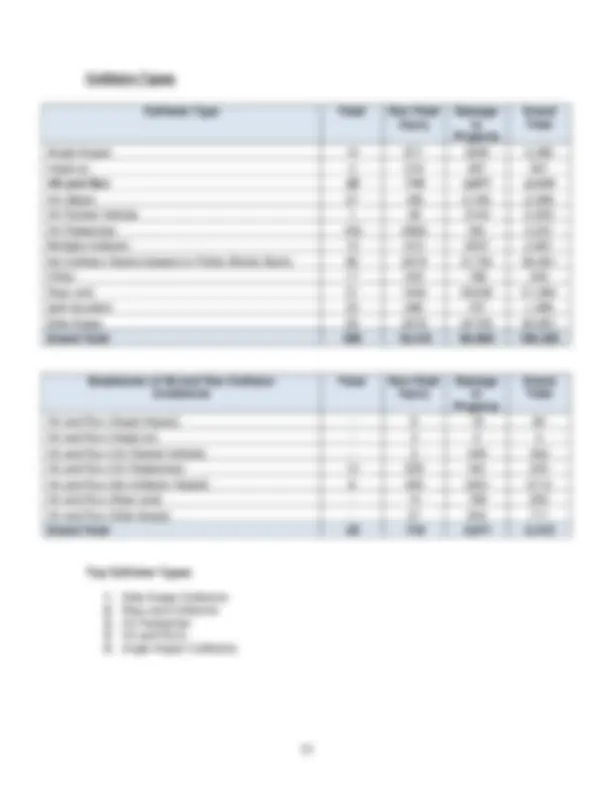



Study with the several resources on Docsity

Earn points by helping other students or get them with a premium plan


Prepare for your exams
Study with the several resources on Docsity

Earn points to download
Earn points by helping other students or get them with a premium plan
Community
Ask the community for help and clear up your study doubts
Discover the best universities in your country according to Docsity users
Free resources
Download our free guides on studying techniques, anxiety management strategies, and thesis advice from Docsity tutors
The Metro Manila Accident Recording and Analysis System (MMARAS) report for the year 2016. It provides information on traffic accidents, including the number of incidents, severity, and locations, as well as the distribution of accidents by vehicle types. The report is produced by the Road Safety Unit of the Metropolitan Manila Development Authority (MMDA) and includes data from individual report forms and recorded road crashes.
What you will learn
Typology: Assignments
1 / 13

This page cannot be seen from the preview
Don't miss anything!








Traffic Accident Report
January to December 2016
Produced by the Road Safety Unit (RSU)
Traffic Discipline Office-Traffic Engineering Center (TDO-TEC)
Metropolitan Manila Development Authority (MMDA)
The Metro Manila Accident Recording and Analysis System (MMARAS) is created and operated by the Road Safety Unit (RSU) of the MMDA-Traffic Discipline Office-Traffic Engineering Center (MMDA-TDO-TEC), with the cooperation and assistance of the Traffic Enforcement Unit (TEU) of the Philippine National Police (PNP).
The objective is to compile and maintain an on-going database of Fatal, Non Fatal Injury and Damage to Property road crashes, which can indicate areas where safety improvements are need to be made. The system will also allow the impact of improvement measures that needs to be monitored.
This report is intended to provide brief information on ‘Fatal’, ‘Non Fatal Injury’ and ‘Damage to Property’ road crashes that have been recorded by the MMDA-Road Safety Unit thru the Police Blotter of the PNP for the year 2016. The information is presented in tabular form, which provides a readily identifiable pattern of accident locations and causation patterns.
The Road Safety Unit currently has 9 data researchers who gather traffic accident data from different traffic offices and stations of the Traffic Enforcement Units (TEU) within Metro Manila. Previously, only those incidences involving Fatal and Non Fatal are gathered and encoded at the MMARAS database. But for the year 2005 up to present, we included the Damage to Property incidence so that we can see the significance and the real picture of what really is happening in our roads and also it gives us additional information in analyzing the causes of accident.
Although influx of traffic accident data increases tremendously, the Road Safety Unit managed to store this damage to property incidences to our MMARAS database and now included in the analysis for the formulation of remedial measures that would be introduced on the identified black spots.
The assistance and cooperation of the traffic investigators will be necessary to maintain an accurate record of the facts surrounding every traffic accident within Metro Manila, since a truly significant picture will only develop over time. The work of the Road Safety Unit will be crucial in providing an appropriate directional trust in the fight to make the roads of Metro Manila a safer place for everyone.
The Metropolitan Road Safety Unit can be contacted for further information or assistance on Tel: 882-4151-57 loc. 1135.
Table 3. Shows the number of road crash incidents/cases by Accident Severity and District, this translates to:
Central Eastern Northern Southern Western Total Fatal 116 46 84 114 66 426 Non Fatal 4,755 3,099 2,327 5,087 1,148 16, DTP 28,846 17,475 5,152 30,914 10,093 92, Total (^) 33,717 20,620 7, 563 3 6,115 11, 307 109,
DTP – Damage To Property
Table 4. Below indicates the distribution of accidents by cities and municipalities in Metro Manila from January – December 2016.
City Fatal Non Fatal Injury
Damage Grand Total Caloocan 36 888 2935 3859 Las Piñas 15 751 2473 3239 Makati 14 1004 11487 12505 Malabon 14 432 674 1120 Mandaluyong 1 503 5219 5723 Manila 66 1148 10093 11307 Marikina 16 1167 3530 4713 Muntinlupa 14 968 2907 3889 Navotas 9 212 550 771 Parañaque 37 1041 4286 5364 Pasay 13 723 4962 5698 Pasig 23 1179 7157 8359 Pateros - 9 26 35 Quezon 116 4755 28846 33717 San Juan 6 250 1569 1825 Taguig 21 591 4773 5385 Valenzuela 25 795 993 1813 Grand Total 426 16 , 416 92 , 480 109 , 322
On the table no. 4, the municipality of Pateros has the lowest number of incidences for the year 2016 from January to December, followed by Navotas and Malabon. We can now consider these LGU’s to be the safest in Metro Manila in terms of road crash incident is concerned, since they have lesser recorded fatal, non-fatal and damage to property incidences in the MMARAS database up to this date. This may be attributed to the following:
On the other hand, the City of Quezon dominates all the cities and municipalities of Metro Manila in terms of fatal road traffic accident followed by City of Makati and then Makati. This is because of the following several factors:
However, problems on road traffic accident in the entire Metropolitan Manila would be given preference by this agency in providing remedial measures on the “blackspots” or accident-prone areas. On this process, traffic accident might be reducing in the future.
Injuries
District
Drivers Injured
Passengers Injured
Pedestrians Injured Total Injured Central 3108 1615 1162 5,
Eastern 2080 1102 761 3,
Northern 1401 951 832 3,
Southern 3028 1691 1760 6,
Western 616 371 398 1,
Total 10, (49.02%)
A person involved in a road accident may indicate a driver, a passenger or a pedestrian. Of these types of persons involved, we have recorded 195 pedestrians (43.72%), 194 drivers (43.50%) and 57 passengers (12.78%) that have been killed in road accidents since January up to December 2016. Looking into persons injured, 10,233 (49.02%) are drivers, 5,730 (27.45%) passengers and 4,913 (23.53%) pedestrians. The relatively high proportion of drivers and pedestrians killed and injured is a cause for concern.
The following table represents the frequency of incidents by time of day. However, there were a number of accidents this year that did not have the time of the incident recorded. These involved eleven (11) fatal, one hundred ninety six (196) non-fatal injury and seven hundred thirty six (736) damage to property accidents.
Time Hour Fatal Non Fatal Injury
Damage Grand Total 00:00-00:59 25 349 1361 1735 01:00-01:59 25 423 1492 1940 02:00-02:59 26 402 1267 1695 03:00-03:59 27 390 1138 1555 04:00-04:59 27 409 1440 1876 05:00-05:59 21 501 1792 2314 06:00-06:59 17 673 3092 3782 07:00-07:59 11 818 4235 5064 08:00-08-59 8 871 4527 5406 09:00-09:59 13 727 4815 5555 10:00-10:59 17 719 5338 6074 11:00-11:59 16 741 5717 6474 12:00-12:59 17 732 5395 6144 13:00-13:59 12 657 4900 5569 14:00-14:59 9 807 5723 6539 15:00-15:59 11 840 5547 6398 16:00-16:59 21 843 5207 6071 17:00-17:59 21 935 4467 5423 18:00-18:59 12 748 4196 4956 19:00-19:59 15 788 5148 5951 20:00-20:59 10 732 4463 5205 21:00-21:59 10 784 3586 4380 22:00-22:59 13 663 3616 4292 23:00-23:59 31 668 3282 3981 No Time Indicated
Grand Total 426 16 , 416 92 , 480 109 , 322 Day-time (06:00-17:55)
Night-time (18:00-05:55)
Overall, 40,823 or 37.34% of accidents occurred during the hours of darkness and without time indicated, while the 68,499 or 62.65% occurred during daytime. But, it can be observed that eventhough most of the accidents occurred at daytime, fatal accidents are considered high during night-time and wee hours in the morning. Drivers, Passengers and Pedestrians are advised to be cautious and attentive during these particular hours.
Collision Type Fatal Non Fatal Injury
Damage to Property
Grand Total
Angle Impact 14 871 3500 4 , 385
Head-on 4 216 287 507
Hit and Run 22 719 4,671 5,
Hit Object 27 185 2,184 2, 396
Hit Parked Vehicle 1 59 2143 2 , 203
Hit Pedestrian 163 4065 NA 4 , 231
Multiple Collision 14 610 2037 2 , 661
No Collision Stated (based on Police Blotter Book) 90 5079 31752 36 , 921
Other 17 333 198 545
Rear-end 21 1635 20238 21 , 894
Self-Accident 33 566 767 1 , 366
Side Swipe 20 2078 24703 26 , 801
Grand Total 426 16 , 416 92 , 480 109 , 322
Breakdown of Hit and Run Collision Incidences
Fatal Non Fatal Injury
Damage to Property
Grand Total
Hit and Run (Angle Impact) - 8 76 84
Hit and Run (Head-on) - 3 2 5
Hit and Run (Hit Parked Vehicle) - 3 449 452
Hit and Run (Hit Pedestrian) 14 229 NA 243
Hit and Run (No Collision Stated) 8 405 3301 3714
Hit and Run (Rear-end) - 14 189 203
Hit and Run (Side Swipe) - 57 654 711
Grand Total 22 719 4, 671 5, 412
Top Collision Types
1. Side Swipe Collisions 2. Rear-end Collisions 3. Hit Pedestrian 4. Hit and Runs 5. Angle Impact Collisions
Accident Factor
Fatal Non Fatal Injury
Damage to Property
Grand Total
Human Error 1 62 144 207
Human Error (Alcohol suspected) 24 20 44
Human Error (Driver Error) 10 769 2421 3200
Human Error (Driver Suffered Dizziness) 1 1
Human Error (Driver Suffered from Asthma) 1 1
Human Error (Driver Suffered from Sugar Loss) 1 1
Human Error (Drivers Error) 1 10 36 47
Human Error (Lost Balance) 1 1
Human Error (Lost Control when applied brake) 1 1
Human Error (Lost Control) 3 15 5 23
Human Error (Passing Thru Red Light) 1 1
Human Error (Tired/Asleep) 1 1
No Accident Factor (based on Police Blotter Book) 411 15514 89809 105734
Other (Road Works) 1 1
Other (Runover a Piece of Stone) 1 1
Other (Runover an Object) 1 1
Other (Slippery Road Due to Oil Spill) 2 4 6
Other (Slippery Road) 1 1 2
Vehicle Defect 1 5 6
Vehicle Defect (Blownout Tire) 2 1 3
Vehicle Defect (Clutch) 1 1
Vehicle Defect (Crash Down) 1 1
Vehicle Defect (Lost Brake) 5 10 15
Vehicle Defect (Mechanical) 5 15 20
Vehicle Defect (Steering Wheel) 1 1
Vehicle Defect (Tire Detached) 2 2
Grand Total 426 16 , 416 92 , 480 109 , 322
Three (3) Accident Causations
MMDA has been coming up with solutions to solve the problem in Road Safety, almost all of the Authority’s projects are geared towards Public Safety. Pedestrians facilities and signage’s are designed to promote safety and convenience, Footbridges has been put up at major choke points where pedestrian volume is high, Sidewalk clearing operations intensified, geometric improvements at accident prone areas undertaken among others. Road Safety is a global concern, and the task to lessen the number of traffic accidents is a high objective but possible with the cooperation and support of the public.
Updated (January 24, 2016) Source : Metro Manila Accident Recording and Analysis System (MMARAS) Database RICHARD DOMINGO